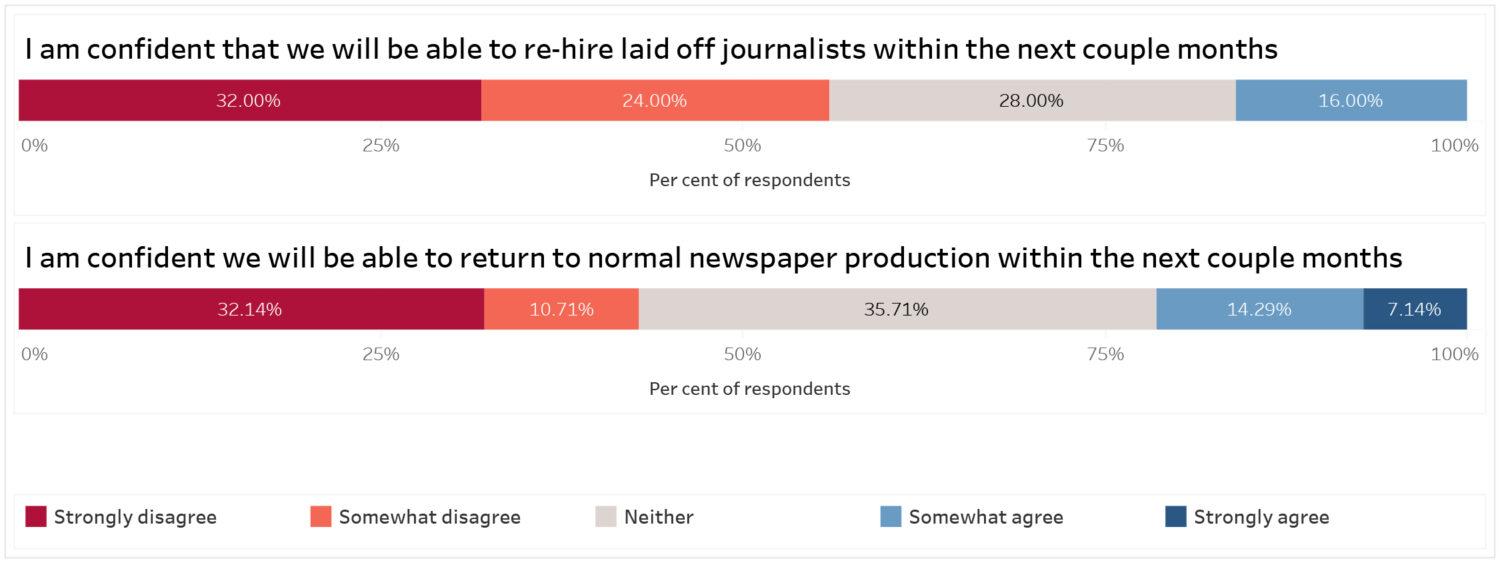As the federal government grapples with regulation of social media platforms, the majority of newsroom leaders in Canada say policy measures to make tech giants share advertising revenue would help support local journalism.
An online survey of 70 senior personnel in English-speaking newsrooms across the country found COVID-19 has had a significant, negative impact on many newsrooms, especially newspapers. Results suggest that increased readership or viewership during the pandemic has not generated increased advertising revenue. And while some newspapers report an increase in the number of paid online subscriptions, reported online subscription revenue covers only a small part of the paper’s costs. Many senior journalists appear open to measures from the federal government to support local journalism.
I sent survey invitations to 160 people in December, mostly managing editors, executive editors and news directors. Only one person per newsroom was invited to participate. However, national news organizations are likely represented more than once. For example, respondents from CBC in two different cities might be included, as well as respondents from different newspapers within the Postmedia chain, for instance.
Of the 70 respondents, 15 work in broadcast, 15 in daily newspapers and 15 in non-daily newspapers. Another 18 respondents declined to indicate the medium.

The most common reported impacts from the COVID-19 pandemic were postponing new hires as well as implementing temporary and permanent layoffs.

(Note that the total number of responses is greater than the number of respondents because they could select more than one option.)
But newspapers appear to have fared worse than other news organizations and were much less likely to report the pandemic had a minimal or no direct impact.

These results also likely don’t include news organizations that had already closed their doors, as documented by the Local News Research Project, the Canadian Association of Journalists and J-Source.
Of the senior journalists who reported either temporary or permanent layoffs, most were not optimistic fortunes would turn around in the near term. Nor were those working for newspapers optimistic about returning to ‘normal’ newspaper production.

Part of the pessimism is likely driven by continuing declines in revenue, despite the fact that most respondents indicated an increase in many news ‘metrics.’
For instance, more than 86 per cent reported online viewership and readership has been higher than normal during the pandemic, along with social media activity and broadcast viewership or listenership. This trend seems intuitive and other surveys have found Canadians have been highly motivated to follow news and information about the pandemic.

But increased readership or viewership and social media activity contrasted with reported revenue numbers. Nearly 85 per cent of respondents said that broadcast revenue was lower than normal and just over 83 per cent of them said that print advertising was lower than normal. About 45 per cent of respondents also indicated that online advertising revenue was lower. This might be expected as a lot of business activity was curtailed or halted after the pandemic was declared, leaving potential advertisers with neither the need nor the resources to buy ads.
One bright spot relates to online subscriptions. Nearly 70 per cent of respondents said that the number of online subscriptions was higher during the pandemic compared with normal. But online subscriptions appear far from universal and make up only a small portion of a news organization’s revenue.
Asked whether their organization charges for online subscriptions, 39 (or 66 per cent) said no, while 20 (34 per cent) said yes. Daily newspapers were far more likely to report charging for online subscriptions.

The median cost for a monthly subscription among the 14 who responded was $14. (One indicated $120, though this may have been an error. If it was meant to be $12, the median would drop to $12.)

One respondent noted, “$60 per year so $5 per month. Wow. That’s cheap when we put it that way.”
Asked how much of the overall costs are covered by online subscriptions, all but two reported “less than 25 per cent.”

This might suggest that subscription costs are much too low. But many senior journalists doubt people in their communities will pay for online subscriptions. None of the respondents indicated that they strongly agreed that people in their communities are willing to pay for access to online news. Almost 50 per cent indicated that they strongly or somewhat disagreed.

The 2020 Reuters Institute Digital News Study found good reasons for this attitude. According to the study, only about 13 per cent of Canadian survey respondents say they pay for online news, though this was up from nine per cent in 2019.
Faced with such continuing revenue challenges during the pandemic, respondents expressed a positive attitude towards government action. More than four-fifths either somewhat or strongly agreed that requiring social media platforms to share their advertising revenue with news organizations would help support local journalism. Respondents were also generally positive towards measures such as Canada’s journalism labour tax credit and the digital news subscription tax credit.

While there are many different policy levers a government might pull, the value of independence runs deep for journalists, particularly when it comes to monitoring and scrutinizing the actions of government. So it may come as a surprise to some that senior journalists — particularly those who work for newspapers — appear to be as open to government action.
“It does surprise me,” said former Toronto Star publisher John Cruickshank. But he also notes that Canada has a long tradition of public broadcasting.
“I think the CBC is a testament to the fact that you can take government money and not be tainted by it, not being influenced by it, or at least not influenced too much.”
Cruickshank himself is open to the idea of direct government support to help sustain local journalism.
“My own feeling is that government grants (for example) are a great way to maintain vital coverage,” said Cruickshank. But he is more divided on how social media platforms fit into the picture.
The advertising dominance of social media giants like Google and Facebook are often cited as a major cause of the financial crisis facing local news, particularly in the wake of Australia’s legislation. But Cruickshank thinks that these companies sometimes get too much of a bad rap.
The erosion of the newspaper business model began long before Facebook was even founded, when platforms like monster.com and Craigslist began to chip away at the lucrative classified advertising revenue, he said.
“They did that by creating better experiences and better results, better experiences for people who were looking for jobs or cars or whatever, and better results for advertisers,” said Cruickshank, who has also held publisher positions at CBC News and the Chicago Sun-Times and was part of the group that produced the Shattered Mirror report in 2017.
“Social media has effectively done the same thing to all other categories,” he said. “They’ve invested billions of dollars — and they’ve had the money we just never had — in an advertising platform that does extraordinary things for advertisers.”
“Having said all that, I think they do get a benefit from the news that is uploaded onto their sites and given their incredible profitability, it wouldn’t hurt them, in their own interests, to invest in … local news.”
Facebook’s Local News Accelerator program is one example, though it’s fair to question whether this is as much of a potential threat to journalism independence as direct support from government. The social media giants will also be negotiating commercial deals with news outlets in Australia, a result of new legislation that will be closely watched around the world. Facebook announced very recently that it will begin a trial in Canada that will pay news publishers.
Many Canadian news organizations have also benefited from the government-funded Local Journalism Initiative.
But other measures may be needed and could be welcomed by journalists. The COVID-19 pandemic has exacerbated the many fault lines in news revenues. Whatever arrangements may be negotiated (or mandated) with social media platforms, this will be just one piece of a complex revenue picture that helps news organizations, especially newspapers, stay afloat and even prosper.
Carleton University, assistant professor

